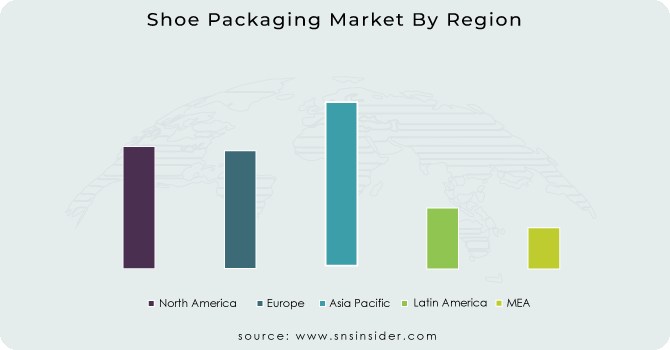Shoe Packaging Market Report Scope & Overview:
The Shoe Packaging Market size was USD 6.44 billion in 2023 and is expected to Reach USD 8.49 billion by 2031 and grow at a CAGR of 3.51 % over the forecast period of 2024-2031. The Shoe packaging market forms an important segment in the broader packaging industry, playing a vital role in protecting Shoe products throughout their journey from producer to consumer. With the continued expansion of the global Shoe market and the growing popularity of e-commerce, the demand for packaging solutions that are efficient, protective and visually appealing has increased dramatically. Shoe packaging is not only used to protect shoes from damage during transportation, but also serves as a marketing and branding tool to influence consumers' purchasing decisions. As brands strive to create unique unboxing experiences and establish distinctive brand identities, innovative packaging designs are becoming increasingly important. Additionally, sustainability concerns are driving the industry towards environmentally friendly packaging materials and practices. The challenge is to balance these eco-friendly options with the need to maintain product integrity and reduce costs. To succeed in this competitive landscape, packaging manufacturers and Shoe brands must tackle complex issues such as customization needs, logistics optimization and regulatory compliance, while keeping up ever-changing consumer preferences and technological advancements.

Get More Information on Shoe Packaging Market - Request Sample Report
MARKET DYNAMICS
KEY DRIVERS:
-
Global Shoe Industry Growth
The Shoe packaging market is strongly driven by the worldwide expansion of the Shoe sector. The demand for appropriate packaging solutions to secure and display Shoe during transit or store visits is also growing, due to the increased consumption of Shoe throughout the world.
-
Growing number of sports enthusiasts is also driving the market.
RESTRAIN:
-
Counterfeit and Piracy
Sophisticated packaging solutions, which can increase costs and complexity, are needed to protect against counterfeit products.
OPPORTUNITY:
-
Efficient Logistics Packaging
Manufacturers and retailers can benefit from savings in costs by reducing packing to optimize utilization of space and lower shipping costs.
-
Integrating the technology into Shoe packaging
CHALLENGES:
-
Waste Management can be a challenging task to handle
Waste streams are generated by the discarding of Shoe packaging. It is difficult to design packaging that has a balance of appeal and waste reduction.
IMPACT OF RUSSIAN UKRAINE WAR
The war has caused a number of disruptions in global supply chains, including those of raw materials, components and finished products. This can lead to higher prices for Shoe and other goods, making it harder for businesses to access traditional packaging materials. In addition, the war raised concerns about the environmental impact of transporting goods over long distances. This could lead companies to look for more sustainable packaging solutions, such as recycled materials or reusable containers.
Finally, war also creates uncertainty about the future of the global economy. This can make companies hesitant to make long-term commitments, such as investing in new packaging technology.
Overall, the impact of the Russia-Ukrainian war on shoe packaging remains unclear. However, it is likely that war will have a certain impact on the industry, as companies seek to mitigate the risks and challenges created by conflict.
IMPACT OF ONGOING RECESSION
Cardboard boxes are the most common type of shoe packaging. They are relatively inexpensive and can be easily recycled. However, they are also bulky and take up a lot of space. As a result, they may become less popular during a recession, when companies are looking for ways to save money on shipping costs. A study from the University of California, Berkeley found that the average shipping cost of a cardboard box increased by 10% in the first quarter of 2023. This will likely lead to a reduction in the use of cardboard boxes for shoe packaging as companies are looking to save on shipping costs. Plastic bags are also a popular type of shoe packaging. They are lightweight and can be easily sealed, making them perfect for transporting shoes. However, they are not recyclable and can pollute the environment. As a result, they are becoming less and less common, especially in countries with strict environmental regulations. A study by the World Wildlife Fund found that the production of plastic bags generates 12 million tons of greenhouse gases each year. This is a major concern during recessions, when businesses seek to reduce their environmental impact. As a result, the use of plastic bags for shoe packaging is likely to be reduced. Shoe boxes are a more expensive type of shoe packaging, but they are also more durable and can protect shoes from damage. They are also commonly used as a marketing tool as they can be used to showcase the brand and style of the shoe. As a result, they are likely to remain popular even during recessions. A study by the National Retail Federation found that the average price of a shoebox increased by 5% in the first quarter of 2023. This will likely lead to a reduction in the use of shoeboxes for shoe packaging. , companies are looking to save money. packaging costs. A study by the International Foam Packaging Association found that the average price of foam inserts increased by 7% in the first quarter of 2023. This will likely lead to a reduction in the use of foam inserts for shoe and business packaging.
KEY MARKET SEGMENTS
By Material
-
Plastic
-
Paper
-
Others
By Market Type
-
Rigid
-
Flexible
By Distribution Channel
-
Online
-
Offline
By Shoes Type
-
Leather Shoes
-
Short Shoes
-
Loafers
-
Casual Shoes
-
Long Boots
-
Running Shoes
By Shoe Packaging Type
-
Tubular Packaging
-
Sustainably Reduced Shoe Boxes
-
Reusable Shoe Packaging
REGIONAL ANALYSIS
Asia Pacific is dominating the Shoe Packaging Market with the market share of 45.5% in 2022. The growing urban population, followed by rapid industrialization is driving the market in the region. The consumption and manufacturing in the region will give boost to the market growth in this region. China is dominating the market in this region with largest market share, followed by India with the fastest growth rate.
North America shoe packaging market is showing fastest growth. The frequent use of shoe and consumers lifestyle. The market in this region is majorly driven by the expansion the US and Canada.
European Shoe Packaging market will show significant growth overt the forecast period. The consumers busy lifestyles which are increasing market for the shoe sales throughout the region. There is demand for various types of shoes, which is increasing the market for shoe packaging. Germany is holding the largest market share.

Get Customized Report as per Your Business Requirement - Request For Customized Report
REGIONAL COVERAGE:
North America
-
US
-
Canada
-
Mexico
Europe
-
Eastern Europe
-
Poland
-
Romania
-
Hungary
-
Turkey
-
Rest of Eastern Europe
-
-
Western Europe
-
Germany
-
France
-
UK
-
Italy
-
Spain
-
Netherlands
-
Switzerland
-
Austria
-
Rest of Western Europe
-
Asia Pacific
-
China
-
India
-
Japan
-
South Korea
-
Vietnam
-
Singapore
-
Australia
-
Rest of Asia Pacific
Middle East & Africa
-
Middle East
-
UAE
-
Egypt
-
Saudi Arabia
-
Qatar
-
Rest of Middle East
-
-
Africa
-
Nigeria
-
South Africa
-
Rest of Africa
-
Latin America
-
Brazil
-
Argentina
-
Colombia
-
Rest of Latin America
Key Players
Some major key players in the Shoe Packaging market are Sneakerbox Co, Packqueen, Cross Country Box Company, Royal Packers, Elevated Packaging, Precious Packaging, Samrat Box Mfg Co Pvt Ltd, Packman Packaging Pvt Ltd, Packaging of the World, Zhuhai Zhuoya Packing Product Ltd and other players.
Packqueen-Company Financial Analysis

RECENT DEVELOPMENT
-
In its global sustainability efforts, Skechers will continue to leave a green footprint. The Manhattan Beach, California based company reported that since 2016, it has reduced the use of plastics in its Shoe packaging by 85%.
-
Nike introduces One Box, which can be converted into shipping box and shoe box.
| Report Attributes | Details |
| Market Size in 2023 | US$ 6.44 Bn |
| Market Size by 2031 | US$ 8.49 Bn |
| CAGR | CAGR of 3.51 % From 2024 to 2031 |
| Base Year | 2023 |
| Forecast Period | 2024-2031 |
| Historical Data | 2020-2022 |
| Report Scope & Coverage | Market Size, Segments Analysis, Competitive Landscape, Regional Analysis, DROC & SWOT Analysis, Forecast Outlook |
| Key Segments | • by Material (Plastic, Paper, Others) • by Market Type (Rigid, Flexible) • by Distribution Channel (Online, Offline) • by Shoes Type (Leather Shoes, Short Shoes, Loafers, Casual Shoes, Long Boots, Running Shoes) • by Shoe Packaging Type (Tubular Packaging, Sustainably Reduced Shoe Boxes, Corrugates Boxes, Reusable Shoe Packaging) |
| Regional Analysis/Coverage | North America (US, Canada, Mexico), Europe (Eastern Europe [Poland, Romania, Hungary, Turkey, Rest of Eastern Europe] Western Europe] Germany, France, UK, Italy, Spain, Netherlands, Switzerland, Austria, Rest of Western Europe]), Asia Pacific (China, India, Japan, South Korea, Vietnam, Singapore, Australia, Rest of Asia Pacific), Middle East & Africa (Middle East [UAE, Egypt, Saudi Arabia, Qatar, Rest of Middle East], Africa [Nigeria, South Africa, Rest of Africa], Latin America (Brazil, Argentina, Colombia Rest of Latin America) |
| Company Profiles | Sneakerbox Co, Packqueen, Cross Country Box Company, Royal Packers, Elevated Packaging, Precious Packaging, Samrat Box Mfg Co Pvt Ltd, Packman Packaging Pvt Ltd, Packaging of the World, Zhuhai Zhuoya Packing Product Ltd |
| Key Drivers | • Global Shoe Industry Growth • Growing number of sports enthusiasts is also driving the market |
| Market Opportunities | • Efficient Logistics Packaging • Integrating the technology into Shoe packaging |

